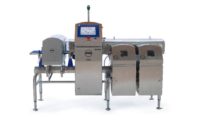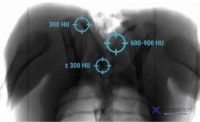Metal detectors verses x-ray machines – are they competing or complementary technologies? While x-ray machines may be considered the ‘see it all’ solution, Fortress Technology president, Steve Gidman, argues both have a place in food manufacturers’ production lines.
The former use a radio frequency transmit system to detect conductive or magnetic metals; the latter, a density discriminator, using light frequency at high energy to pass through a product to identify mass.
Performance
“With a metal detector, metals that have one or both conductive/magnetic characteristics, such as stainless steel, brass, bronze, ferrous metals etc., will create a detectable signal. With an x-ray machine, the light waves pass through the product to be inspected. Anything very dense will block the waves. Yet, low density materials, such as wood, feathers, bugs, some stones/glass, magnesium and aluminum, will pass straight through.
“The very nature of a metal detector means there are limitations; ferrous metals and products that have one or more of the characteristics are easier to detect, but metal such as non-magnetic stainless steel is harder to pick up as this metal is a bad conductor. Certain food products with added iron, moisture, salt and acids, also tend to mask metal detection. Known as the ‘product effect’, this can impact the detector’s performance.
“Research shows metal is the most common contaminant source - it’s in the factory, in farms and fields. So, when it comes to doing its job, the metal detector is number one. And it isn’t only dry products where this technology works. Technology has moved forward so even conductive products, especially those with small packaging consistently presented to the detector, can be inspected.”
Steve reminds it’s never worth replacing a metal detector with an x-ray machine, as users will lose ‘virtually all detection’ of low density metals unless a ‘very large chunk’ presents itself.
“Some metals, such as the very thin aluminum used in soda can production, are impossible to see. If you cut a can into three or four pieces, it’s likely none of these pieces will be detectable in an x-ray machine, either inside or on top of a food product. Materials with a greater density, such as metal packaging, whole cans, aluminum foil, pie plates and moist contaminants, will however be picked up by x-ray.”
Cost and maintenance
“From a cost perspective, the metal detector is typically the first choice. But if you have other items or contaminants on a production line - stainless steel at a lower level, glass, rock and bone for example, then in addition to the detector, it could be worth investing in an x-ray machine. Be mindful though, it could cost 5-10 times more than a detector and the budget for regular yearly inspections would likely be 20-30 times higher.”
Environmental issues, such as moisture build-up, are another consideration. Steve suggests that while x-ray machines are built to withstand water, they don’t like it around them. Similarly, dust, heat and cold temperatures will shorten an x-ray’s life span, or at least their components.
Steve explains: “X-ray machines are not well suited to in-house mechanics or repairs. Safety issues around radiation and dealing with potentially high-voltage components means manufacturers often need to bring in engineering expertise and source specific parts, resulting in potentially longer production line stoppages.
“Metal detectors have less to go wrong – there are no heat sources and they can quickly be repaired by maintenance teams. Most food plants can easily get a detector up and running with some spare parts or settings. Making it better to have a detector in place, particularly if a line needs to be shut down because of a critical control point failure.”
Line positioning
When working together, Steve says the x-ray machine will favor an in-line inspection position while metal detectors are better located towards the end of the processing line, often after packaging. Additionally, gravity systems where product is moving through an aperture at very high speed won’t lend themselves well to x-ray detection.
“Keep metal detectors at the critical control points but use both on the line. Consider an x-ray machine as a fail safe bonus - both work well together.”
Operator safety
Metal detectors are widely recognized as safer machines - computer displays are said to generate more radio frequencies. “For operatives, there’s definitely a higher safety risk with x-ray machines and there are clear rules limiting how much leakage is allowed. The cabinet size and length to absorb the x-ray, particularly at the entrance and exits, is dictated by the power output.”
Complimentary technologies
“While an x-ray machine will be able to detect things a metal detector can’t, it’s important to do your research. If, after product risk analysis, you consider one is necessary, have both. They’re complimentary technologies.
“A metal detector should be a given and an x-ray machine only if there are specific needs, such as potential contaminants that won’t detect well. And of course if the budget allows.”
For more details, listen to the latest Fortress Technology food safety podcast featuring Steve Gidman.



